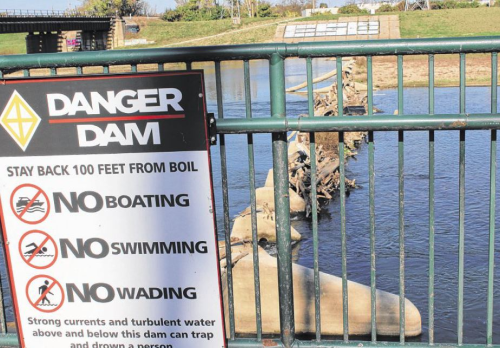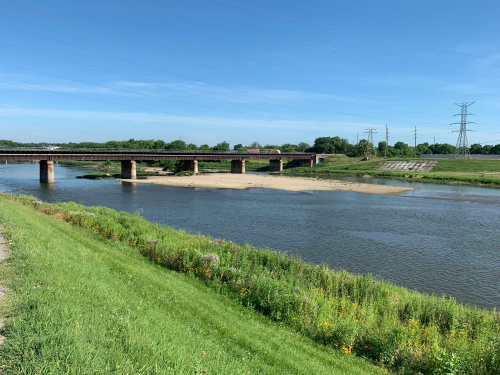Along Southwest Ohio’s rivers, lowhead dams are small, often deceptively calm structures with water flowing over their tops. While modest in appearance, they pose serious hazards—especially to recreational users such as kayakers, swimmers, and anglers. Known as “drowning machines,” the recirculating currents at their base can trap even strong swimmers, making safety a critical concern for communities along the Great Miami River.
It’s important to distinguish lowhead dams from high-hazard dams. High-hazard dams are large structures whose failure would threaten lives or property, and they are subject to strict engineering standards and inspections.
Lowhead dams, by contrast, were never designed for flood control. Instead, they were built for purposes such as:
Industrial use – powering mills and factories
Water supply – providing water for communities or agriculture
Navigation or recreation – creating pools for boating or fishing
Though historically useful, many lowhead dams no longer serve their original function and, in some cases, create environmental or safety challenges.
The Miami Conservancy District (MCD) is actively working with communities along the Great Miami River to improve safety, ecological health, and recreational access near lowhead dams. Several projects involve dams owned by MCD or adjacent to MCD property:
Troy – Great Miami River (“Troy Low Dam”)
Located near MCD levees, this dam is part of the Troy Low Dam Removal & River Improvement Project managed by the City of Troy. Hydraulic modeling shows that removing the dam improves river conditions while protecting the city’s levee system. The project also includes habitat restoration and new recreational connections.
Piqua – Great Miami River (“Piqua Low Dam”)
Owned by the City of Piqua, this dam no longer serves its original purpose and contributes to oxygen depletion and hazardous currents. Funded by Ohio EPA WRRSP, H2Ohio, and USFWS, the project will remove the dam, improve fish passage, restore habitat, and expand recreation opportunities.
Dayton – Great Miami River (“Island Low Dam”)
While the City of Dayton owns this dam, MCD owns or controls the adjacent riverbanks and maintains the left-bank portage. In 2025, MCD supported a University of Dayton River Stewards project that led to new signage and safety information to reduce hazards for recreational users.
West Carrollton – Great Miami River (“South Montgomery County Low Dam”)
Owned by MCD, this dam is part of a new river district redevelopment plan. The City of West Carrollton is advancing a $2.8 million project with dam safing improvements and a new whitewater park, with MCD engineers serving on the selection committee for project management.
Miamisburg – Great Miami River (“Hutchings Station Low Dam”)
MCD owns or controls parcels upstream of this former DP&L dam. Frontier Group, the current owner, is exploring removal options with MCD to support habitat restoration and mitigation credits.
Hamilton – Great Miami River (“Hamilton Low Dam” and “Two Mile Low Dam”)
Both dams are owned by MCD. The USACE completed a feasibility study exploring removal or modification to improve recreational access, safety, in-stream habitat, and sediment management, while ensuring flood protection from MCD’s system remains intact. Two-Mile Low Dam has been prioritized by ODOT for funding to generate mitigation credits, with design potentially starting in 2026–2027.
Covington – Stillwater River (“Covington Low Dam”)
MCD is supporting the Village of Covington in removing this dam, including a $2,500 contribution to develop conceptual design under USFWS grant support.
Even with improvements underway, lowhead dams remain a hidden danger. MCD encourages river users to stay alert, respect signage, and avoid entering the hydraulic zone below these dams. Projects along the Great Miami River aim to reduce hazards while enhancing ecological health and public access. All hazards are listed on the Water Trail Maps, available here.
Tait Station Dam Removal
In 2018, MCD removed the Tait Station Low Dam on the Great Miami River near Dayton. Originally constructed in 1935 to supply cooling water for a coal-fired power plant, the dam no longer served its purpose after the plant closed in 1983. MCD acquired the dam in 1990. Fully funded by the Ohio Department of Transportation at $1.75 million, the removal eliminated hazardous hydraulic conditions and improved river safety. The project also included a natural rock riffle to enhance fish habitat and water quality.
Watch the time-lapse video here.
BEFORE AND AFTER TAIT STATION REMOVAL


Englewood Lowhead Dam
In September 2009, Five Rivers MetroParks removed the lowhead dam at Englewood Reserve on the Stillwater River. Originally built for recreation, the dam had become a significant safety hazard. The $1.5 million removal restored the river’s natural flow and improved both ecological health and public safety.
Monument Dam Transformation
In 2017, MCD and Five Rivers MetroParks collaborated with the City of Dayton to transform the Monument Avenue Low Dam into a $4 million feature of the RiverScape River Run whitewater park. Modifying the dam created a safe and exciting environment for kayakers and canoeists, revitalizing the riverfront and attracting locals and visitors alike.
Lowhead dams are a historical part of our rivers, but their risks are very real. Through careful planning, partnerships, and targeted projects, MCD is improving safety and accessibility while helping rivers thrive as recreational and ecological resources. From Troy to Hamilton, our work ensures communities can enjoy safe, vibrant waterways for generations to come.